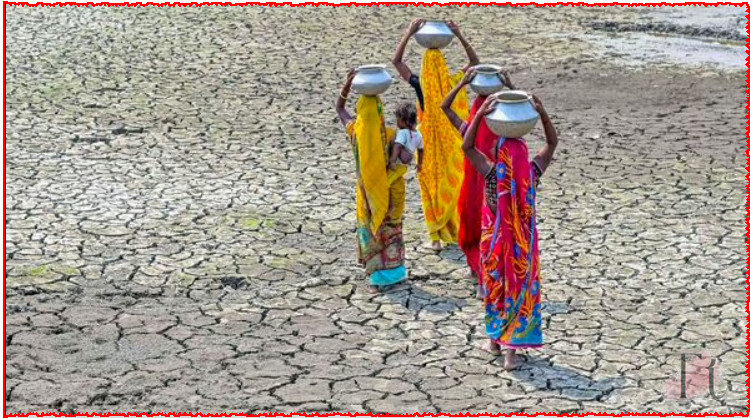Introduction
The Indian state of Rajasthan is currently experiencing an intense heatwave that has led to multiple fatalities and dangerously high temperatures. This extreme weather event has significantly worsened the already challenging living conditions in the region, highlighting the urgent need for effective mitigation and adaptation strategies.

Table of Contents
Rajasthan, known for its arid and semi-arid climate, is no stranger to high temperatures during the summer months. However, the current heatwave has pushed temperatures to unprecedented levels, with some areas recording highs of up to 49 degrees Celsius. This severe heat has not only claimed lives but also strained public health systems, disrupted daily activities, and heightened the risk of heat-related illnesses across the state.
The immediate impact of the heatwave is evident in the number of deaths reported due to suspected heat stroke. The fatalities have been recorded in various districts, including Balotra, Bhilwara, Bikaner, and Jodhpur. These tragic incidents underscore the lethal threat posed by extreme heat, especially to vulnerable populations such as the elderly, children, and those with pre-existing health conditions.
In response to the crisis, authorities in Rajasthan have taken several steps to manage the situation and prevent further casualties. The health department has mandated death audit committees to investigate suspected heat stroke deaths thoroughly before officially attributing them to the heatwave. This measure aims to ensure accurate reporting and understanding of the causes of death, which is crucial for formulating effective public health responses.
The broader context of this heatwave can be linked to global climate patterns. Scientists have predicted an increase in heatwave days due to fewer non-monsoon thundershowers and the influence of the El Nino phenomenon, which typically brings warmer temperatures. This trend suggests that the current heatwave in Rajasthan may be part of a larger pattern of climate variability and change affecting the region.
Overall, the situation in Rajasthan serves as a stark reminder of the severe impacts of extreme weather events exacerbated by climate change. It underscores the need for robust heat action plans, public awareness campaigns, and long-term climate adaptation strategies to protect vulnerable populations and enhance the region’s resilience to future heatwaves.
Current Situation of Rajasthan
As of the latest reports, Rajasthan has recorded six more deaths due to suspected heat stroke, with temperatures reaching a staggering 49 degrees Celsius. The deaths occurred in various parts of the state: three in Balotra, and one each in Bhilwara, Bikaner, and Jodhpur. This brings the total number of deaths due to suspected heat stroke to nine within a short period.

The extreme heat has not only affected Rajasthan but also other parts of North India, including the national capital, Delhi. The India Meteorological Department (IMD) has issued an ‘orange’ warning for Delhi from May 25-27, predicting maximum temperatures of 42 degrees Celsius and minimum temperatures of 31 degrees Celsius.
Temperature Records and Affected Areas
The current heatwave sweeping across Rajasthan has set alarming temperature records, significantly impacting various parts of the state. The most extreme temperatures were observed in Phalodi, which reported a staggering high of 49 degrees Celsius. This extreme temperature marks Phalodi as one of the hottest places not just in Rajasthan but globally during this period, underlining the severity of the heatwave.
Other areas in Rajasthan have also faced extremely high temperatures, each contributing to the overall crisis. Jaisalmer, known for its historic forts and desert landscapes, recorded a temperature of 48.3 degrees Celsius. The nearby region of Barmer was not far behind, experiencing 48.2 degrees Celsius. These temperatures are exceptionally high even by Rajasthan’s standards, reflecting the intensity of the current weather conditions.
In Jodhpur, often called the “Blue City” due to its painted houses, the temperature reached 47.6 degrees Celsius. This heat has significant implications for the local population, as the city is a major urban center with a dense population. The temperature in Kota, another significant city in Rajasthan, soared to 46.7 degrees Celsius. Kota, an educational hub known for its coaching centers, is particularly affected as the high temperatures disrupt the daily lives of students and educators alike.
Ganganagar recorded a temperature of 46.6 degrees Celsius. Situated near the border with Pakistan, Ganganagar is a crucial agricultural region. Such high temperatures can severely impact crop yields and water resources, posing a threat to food security and the livelihoods of farmers.
Bikaner, with its rich cultural heritage, faced a temperature of 45.8 degrees Celsius. Churu, another area known for its historical significance, reported 44.8 degrees Celsius. These temperatures are distressingly high and can exacerbate existing challenges such as water scarcity and health issues.
The capital city of Jaipur, renowned for its palaces and tourist attractions, recorded a temperature of 42.8 degrees Celsius. While this is slightly lower compared to other parts of the state, it still represents a significant health risk, especially for the vulnerable population including children, the elderly, and those with pre-existing health conditions.
These extreme temperatures have far-reaching consequences. They increase the risk of heat-related illnesses, such as heat exhaustion and heat stroke, and place a heavy burden on the healthcare system. The high temperatures also disrupt daily activities, making it hazardous to spend extended periods outdoors. Additionally, the demand for electricity surges as people rely more on air conditioning and cooling devices, which can strain power grids and lead to outages.
Government and Health Department Response
In response to the fatalities, the health department has issued directives for death audit committees to investigate each case before officially declaring them as heat stroke deaths. Additional Chief Secretary (Health) Shubhra Singh emphasized that deaths in medical institutions should be scrutinized by these committees, and only after thorough investigation should they be reported on the IHHP portal as heat stroke deaths. The government has stressed the need for rigorous protocols and has warned against any negligence in handling heatwave-related medical cases.

Broader Climate Context
India’s summer temperatures typically peak in May, but this year, scientists have predicted more heatwave days than usual. This prediction is attributed to fewer non-monsoon thundershowers and an active but weakening El Nino weather phenomenon. El Nino events are known to increase global temperatures and alter weather patterns, often resulting in hotter and drier conditions in many parts of the world, including India.
Impact on Public Health and Daily Life
The extreme heat has severe implications for public health. Prolonged exposure to high temperatures can lead to heat exhaustion, heat stroke, and aggravate pre-existing health conditions, particularly among vulnerable populations such as the elderly, children, and those with chronic illnesses. The health department’s directive for rigorous investigation into heat stroke deaths underscores the seriousness of the situation.
The heatwave also disrupts daily life. Outdoor activities become hazardous, agricultural productivity can decline, and there is an increased demand for electricity due to higher use of air conditioning and cooling devices, which can strain power supplies. Water scarcity is another critical issue, as high temperatures increase evaporation rates and reduce the availability of water for drinking and irrigation.
Government Measures and Recommendations
To mitigate the impact of the heatwave, the government has implemented several measures. These include:
Heat Action Plans: These plans are designed to provide guidelines for dealing with heatwaves, including early warning systems, public awareness campaigns, and measures to protect vulnerable populations.
Health Advisories: Issuing advisories to the public on how to stay safe during extreme heat, such as staying indoors during peak heat hours, staying hydrated, and recognizing the signs of heat-related illnesses.
Infrastructure Improvements: Enhancing the infrastructure in healthcare facilities to handle heat-related emergencies, including ensuring a steady supply of essential medicines, cooling equipment, and uninterrupted power supply.
Water Management: Implementing water conservation and management strategies to ensure adequate water supply during the heatwave.
Community Support: Mobilizing community resources and local governments to provide support, such as setting up cooling centers and distributing water in affected areas.
Long-Term Strategies
Addressing heatwaves requires not only immediate measures but also long-term strategies to build resilience against extreme weather events. These strategies include:
Urban Planning: Developing urban infrastructure that reduces heat accumulation, such as increasing green spaces, improving ventilation in buildings, and using reflective materials in construction.
Agricultural Practices: Promoting agricultural practices that are resilient to high temperatures, such as drought-resistant crops and efficient irrigation techniques.
Climate Adaptation: Investing in climate adaptation measures to better prepare for and respond to extreme weather events. This includes improving weather forecasting capabilities, developing early warning systems, and conducting public education campaigns on climate resilience.

Policy Integration: Integrating climate change adaptation into national and regional policies to ensure a coordinated and effective response to the challenges posed by extreme weather.
Role of International Community
The international community also plays a crucial role in supporting countries like India in coping with extreme heatwaves. This can be through:
Technical Assistance: Providing technical assistance in developing and implementing heat action plans and climate adaptation strategies.
Financial Support: Offering financial support for infrastructure improvements, capacity building, and emergency response measures.
Knowledge Sharing: Facilitating the sharing of best practices and lessons learned from other countries that have successfully managed similar challenges.
Research and Development: Supporting research and development initiatives aimed at understanding the impacts of climate change and developing innovative solutions to mitigate its effects.
Conclusion
The heatwave in Rajasthan is a stark reminder of the growing challenges posed by climate change. As temperatures continue to rise and extreme weather events become more frequent, it is crucial to implement both immediate measures to protect public health and long-term strategies to build resilience against future heatwaves. The efforts of the government, supported by the international community, will be vital in addressing these challenges and ensuring the safety and well-being of the population.
This comprehensive approach, combining immediate response with long-term planning, can help mitigate the impact of extreme heat and build a more resilient and sustainable future for Rajasthan and other affected regions.
Read more about IPL 2024: RCB vs RR Eliminator – Do-or-Die Battle


1 thought on “Heatwave Crisis in Rajasthan 2024: A Detailed Examination”